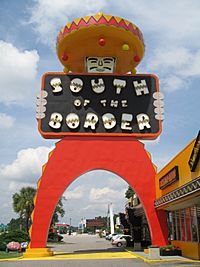South of the Border (attraction) facts for kids

South of the Border's large welcome sign
|
|
| Location | Hamer, South Carolina, United States |
|---|---|
| Coordinates | 34°29′52″N 79°18′35″W / 34.49778°N 79.30972°W |
| Opened | 1950 |
South of the Border is a famous roadside attraction in Hamer, South Carolina, United States. It sits right on I-95, US 301, and US 501. The name "South of the Border" comes from its location just south of the border between North Carolina and South Carolina.
For many years, it was a popular stop for travelers heading to Florida from New York. The whole place has a fun, faux-Mexican theme. You can find restaurants, gas stations, a motel, shops, and even a small amusement park here. There's also a mini-golf course and fireworks stores. The mascot is a cartoon character named Pedro. South of the Border is well-known for its many billboards that start miles away, counting down how far you are from the attraction.
Contents
Fun Design and Attractions
South of the Border is designed to be a fun and colorful place. It covers about 350 acres, which is a huge area! Here, you can play miniature golf or stay at the 300-room motel. There are many souvenir shops to explore and several restaurants to eat at.
One of the coolest features is a 200-foot tall observation tower. It has a sombrero-shaped top where you can look out over the area. South of the Border is also home to "Reptile Lagoon." This is the largest indoor reptile exhibit in the United States, full of amazing creatures.
You'll see lots of bright, flashing signs and huge statues of animals like dolphins, horses, and dinosaurs. The Peddler Steakhouse, one of the restaurants, is even shaped like a giant sombrero!
Motocross Training
For those who love dirt bikes, South of the Border has a motocross training facility. It's called South of the Border Motocross (SOBMX). Riders come here to train and compete in races. There are different tracks, including a 1.4-mile motocross track. Only professional riders with special licenses can use some of the advanced tracks.
A Look at History
South of the Border was started by a man named Alan Schafer in 1950. It began as a small beer stand in 1949. Over time, it grew bigger and bigger. Alan Schafer started bringing in fun Mexican trinkets and other unique items.
Soon, the site added a cocktail lounge, a gas station, and a souvenir shop. In 1954, a motel was built. By 1962, South of the Border began selling fireworks. This was a smart move because fireworks were not allowed in North Carolina at the time.
In 1964, it was announced that the new I-95 highway would pass right by South of the Border. This made it even easier for travelers to visit. By the mid-1960s, the attraction had grown to include a barber shop, a drug store, and an outdoor go-kart track. A 104-foot tall statue of Pedro, the mascot, was also added.
In 2025, South of the Border offered about 30 acres of its property for sale. This included undeveloped land, a motel building, and former casino and convention centers. The main parts of the attraction are still open and operating.
Meet Pedro, the Mascot
At first, South of the Border only used pictures of sombreros and serapes in its ads. Then, Alan Schafer hired two men from Mexico. People started calling them Pedro and Pancho. This led to the creation of the Pedro mascot.
Pedro is a cartoon character with a sombrero, a poncho, and a big mustache. Some people have found Pedro's design to be a bit old-fashioned or not quite right. However, the creator, Alan Schafer, always said it was meant to be a fun joke. Today, all employees at South of the Border are called "Pedro" as a friendly nickname.
South of the Border in Pop Culture
South of the Border has appeared in several movies and TV shows:
- The American storyteller Jean Shepherd started his TV movie, The Great American Fourth of July and Other Disasters, with a trip to South of the Border.
- In the TV show Eastbound & Down, a scene shows characters robbing a gift shop at South of the Border.
- The movie Impractical Jokers: The Movie features the Jokers sending one of their friends to South of the Border on horseback.
- In the 1999 movie Forces of Nature, starring Sandra Bullock and Ben Affleck, the main characters stop at South of the Border while on a bus trip.
See also
- Breezewood, Pennsylvania
- Tourist trap
- Carowinds

